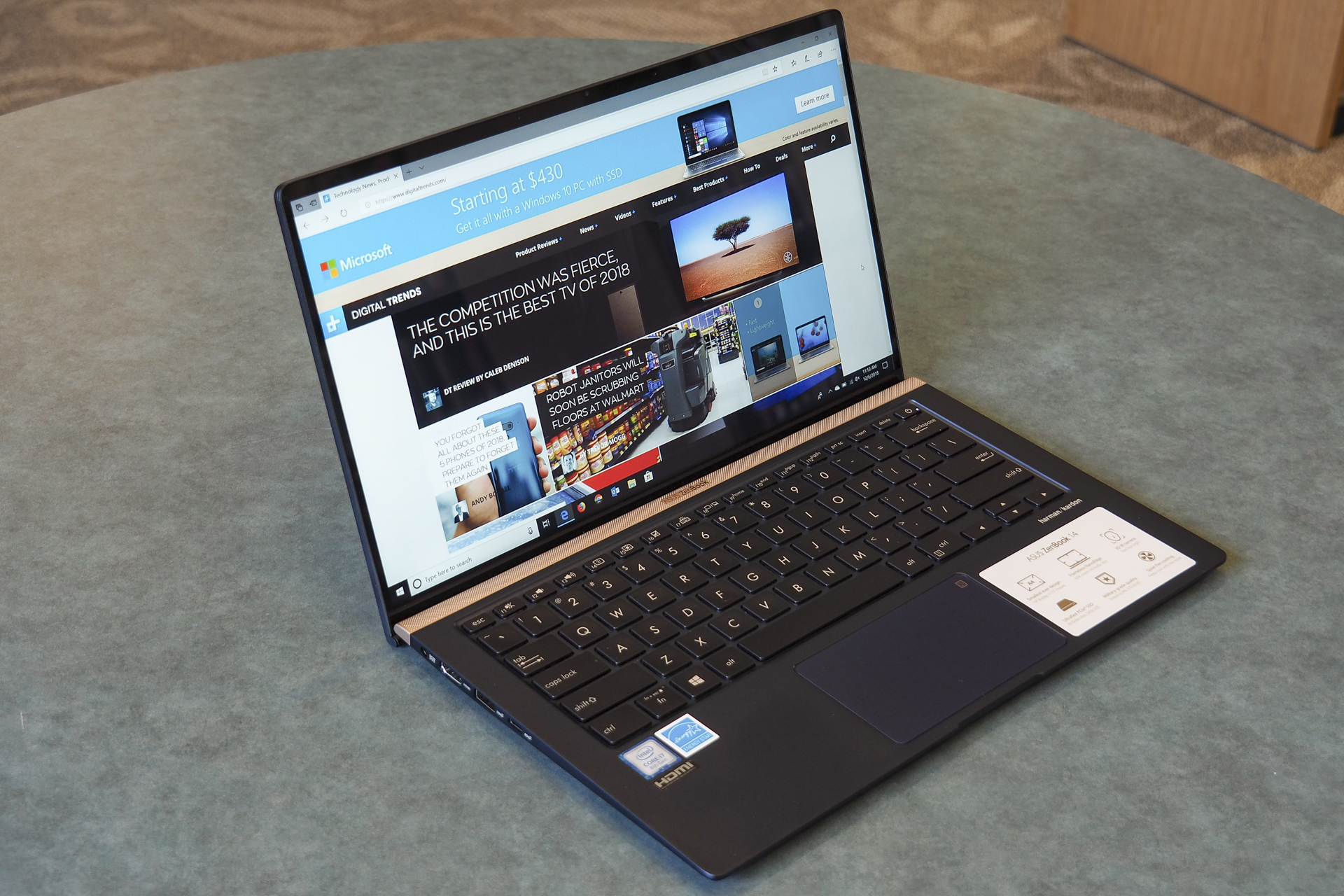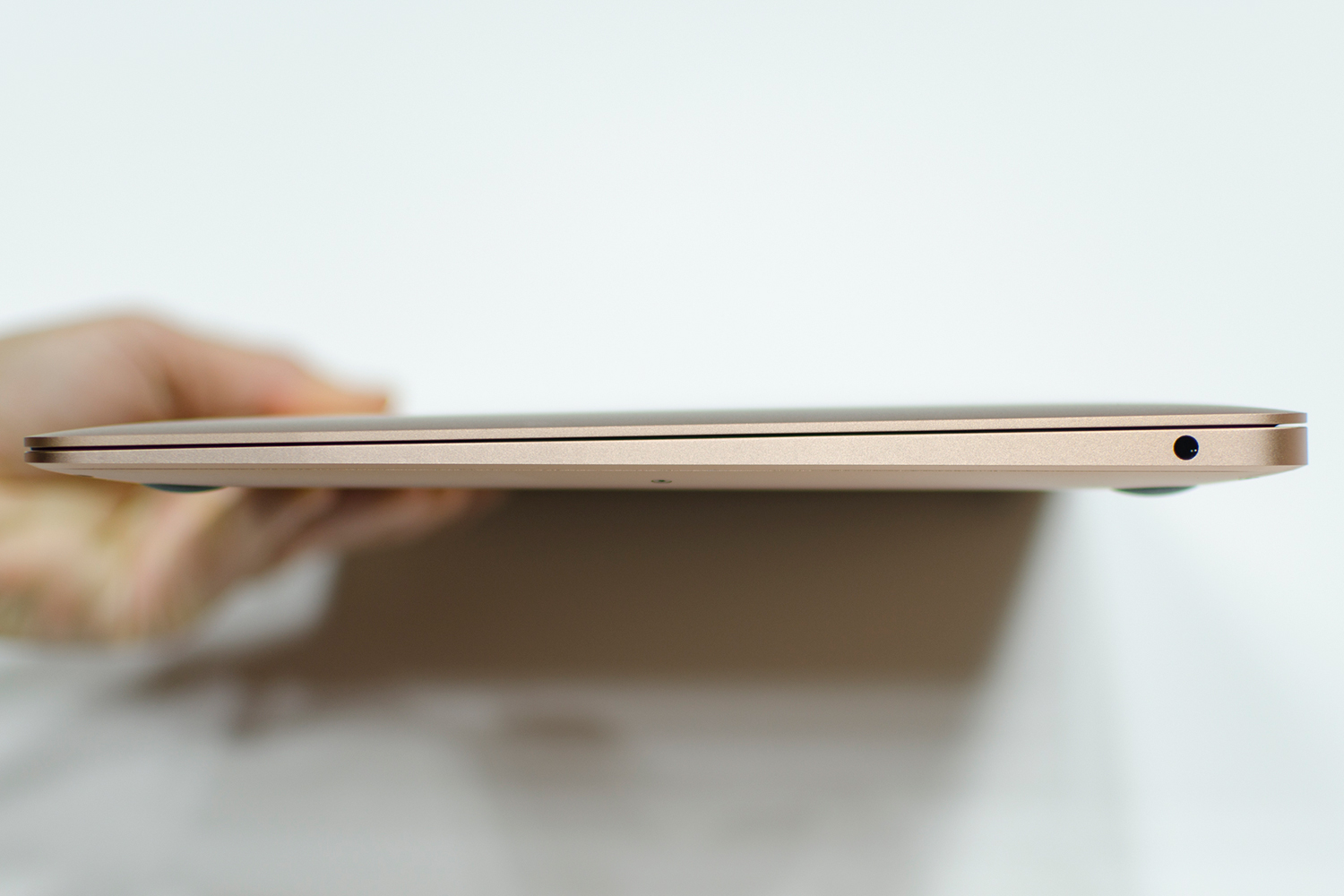2020 was a big year for the MacBook Air. In March, Apple ripped out the lackluster keyboard and replaced it with the Magic Keyboard featuring scissor switches, a significant upgrade to Apple’s previous butterfly design. Then, in November, Apple kicked Intel to the curb and installed its own in-house processor, the M1, in a second refresh.
One of its biggest contenders is the Asus ZenBook 14. Taking cues from Apple, it’s thin and light and has tiny bezels to fit a 14-inch display in a chassis usually reserved for 13-inch panels. Does it beat out the industry’s trendsetter?
Note: This comparison is based on the latest MacBook Air (November 2020) and the Asus ZenBook 14 UX433 (2018).
Design

The first thing you’ll notice when opening the ZenBook 14 UX433 is the expanse of display framed by so little bezel. The MacBook Air has smaller bezels than its predecessors, but those bezels simply can’t compete with the Zenbook. Despite being a 13.3-inch laptop, the Air’s overall frame is almost half an inch wider than the 14-inch Zenbook — that’s all thanks to its chunkier bezels. Neither notebook has a touch display.
The ZenBook 14 UX433 is almost as solidly built as the MacBook Air, which benefits from the usual Apple-quality construction. Asus subjected it to the full range of MIL-STD-810G military standard testing, and the lid and chassis are just as rigid as the excellent MacBook Air’s. But the ZenBook’s keyboard deck is more flexible. In that regard, the Asus is a step behind.
Aesthetically, the ZenBook 14 UX433 comes in Royal Blue and Icicle Silver with gold trim, including a gold bar above the keyboard that looks a lot like a soundbar but is actually just ornamental. The MacBook Air retains its wedge shape, though it’s smaller than the original. Overall, it still looks a lot like a Mac — and that’s a good thing. You can get it in three very luscious colors: gold, silver, and Space Gray.
On the keyboard front, the MacBook Air has one of the best laptop keyboards to date, leaving the ZenBook in the dust. Moreover, the MacBook Air sports the usual large — and excellent — Apple touchpad with Force Touch support. Meanwhile, the ZenBook 14’s more traditionally-sized Microsoft Precision touchpad works well and offers the innovative NumberPad LED numeric keypad for number crunchers.
Finally, the ZenBook 14 focuses on strong legacy support by including two USB-A ports, one USB-C port without Thunderbolt 3, a full-size HDMI connection, and a microSD card reader. The MacBook Air is all-in on the future, with just two USB-C ports with 40Gbps Thunderbolt 3 support. Both have an audio jack.
Overall, the ZenBook 14 deserves some kudos for squeezing a large display into a chassis that’s similar in size to the MacBook Air’s, and its NumberPad is a nice feature for people who work with numbers. But you can’t beat Apple’s build quality, especially given the ZenBook’s spongy keyboard deck.
Performance

This is where we compare apples to oranges.
Asus equipped the ZenBook 14 UX433 with eighth- and 10th-generation Intel Core CPUs, quad-core processors that are both faster and more efficient than the previous generation. Our review unit used the Core i7-8565U, but the ZenBook has multiple configurations spanning seven processors up to the Core i7-10610U vPro. As a mainstream comparison, we threw in the Core i7-10510U instead, which has slightly better performance than the eighth-gen chip.
For this generation of MacBook Air, Apple ditched Intel for its own in-house, ARM-based chip, the Apple M1. In benchmarks, it outperformed both Intel chips in the ZenBook by a large margin, hitting roughly a score of 1,737 in the single-core Geekbench test and a 7,685 in the multi-core test. The 10th-gen Intel chip managed around 1,250 and 3,991, respectively.
Meanwhile, the MacBook Air uses a much faster PCIe solid-state drive (SSD) than the ZenBook 14. That makes it better at opening and saving files and booting the operating system.
Display quality is another important performance factor. Here, the MacBook Air’s 13.3-inch display is much sharper at 2560 x 1600 compared to the full HD (1920 x 1080) 14-inch display on the ZenBook 14. Apple’s panel has a wider and more accurate color gamut, too. But in our testing, the Asus display was brighter and had better contrast and a more accurate gamma (so video will be neither too light nor too dark) than the comparable MacBook Air at the time.
Ultimately, neither offer the best display you can get, but between the two, we would choose the MacBook Air’s panel for its better colors and considerably higher sharpness.
The bottom line here is that the new M1-based MacBook Pro provides better baseline performance than the now-outdated ZenBook 13 UX433. But here’s the kicker: Desktop software developed for Intel-based Macs must now run through an emulator built into MacOS Big Sur, aka Rosetta 2. This may impact performance in those programs until developers release a version that natively supports Apple’s M1 chip.
That said, despite the older hardware, the ZenBook 14 UX433 may handle Intel-based programs better than the MacBook Air.
Portability

The ZenBook 14 is 0.63 inches thick and weighs 2.62 pounds. The MacBook Air measures 0.63 inches at its thickest point and weighs slightly more at 2.8 pounds. These two notebooks are thin, light, and small enough to slip into a backpack and use on the go.
There are other important probability factors, such as battery life. The battery capacity for both is 50 watts, but the MacBook Air has the upper hand due to the new ARM-based M1 chip. This is why smartphones and tablets don’t use Intel CPUs: ARM’s design is better at targeting high performance while sipping power from the battery.
That holds true in this scenario. For example, the MacBook Air lasted 15.5 hours in our browser benchmark and 18.5 hours in our video test. The Asus notebook saw less than eight hours in the browser test and 10.5 hours in our video test.
If your priority is mobility, the MacBook Air has you covered, and then some.
MacBook Air just offers more

The ZenBook 14 UX433 is a budget-flexible notebook for users. It’s hard to buy new unless you’re willing to pay an insane price. On Amazon, a version similar to the review unit sells for at least $999 used — new units start at $2,000. That said, if you already have this notebook and are thinking about an upgrade, the MacBook Air should definitely be on your radar.
When comparing the two at these price points, the $999 MacBook Air features an Apple M1 chip, 8GB of RAM, and a 256GB SSD. If you’d prefer a higher-quality MacBook Air with an M1 chip, 16GB of RAM, and a 2TB SSD, expect to spend a solid $2,050.
The ZenBook 14 UX433 is arguably still a fantastic product, even with its outdated hardware. However, the MacBook Air often outperforms in performance power, visual displays, and battery life. The only potential downside we can note for the Air is that desktop software performance is slightly questionable. The newer Air uses an emulator to run Intel-based programs, which could potentially cause issues.
On top of that, we still have the classic Windows 10 versus MacOS debate, too. The Asus device runs on Windows 10, while the Air has MacOS. Each of these operating systems has its unique user interface and features. If you exclusively prefer one operating system over the other, look for a modern Windows 10 PC or the MacBook Air, depending on your preferences.
Editors' Recommendations
- The 5 best MacBooks for video editing in 2024
- The best MacBook to buy in 2024
- Best laptop deals: Save on the Dell XPS 14, MacBook Pro 16 and more
- Best Apple deals: Save on AirPods, Apple Watch, iPad, MacBook
- The MacBook Air 15 vs. MacBook Pro 14: the easy way to decide


